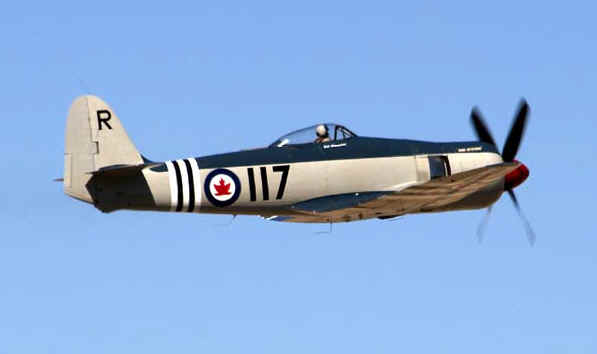


Sea Fury "Bad Attitude" at Reno, Nevada,
USA, September 2003.
Photo by C.F. Smith
HAWKER Sea Fury
|
Aus der nicht besonders erfolgreichen Tempest entwickelte Hawker einen der weltbesten Jäger mit Kolbenmotoren. Der Prototyp dieses Fury genannten Musters entstand auf eine gemeinsame Ausschreibung von RAF und FAA hin. Es folgte die Marineausführung Sea Fury, die die Stütze der FAA-Jägerflotte bildete und sich in den Kämpfen über Korea durch zahlreiche MiG-Abschüsse als ein hervorragendes Jagdflugzeug erwies. Die zeichnungen für die Sea Fury I erstellte Hawker, und die Verantwortung für die Sea Fury X lag bei Paul Boulton. Die Sea Fury mit Griffon Motor hatte einen gegenläufigen Sechsblattpropeller. Die ersten Export Fury gingen in die Niederlande und andere nach Burma, Kuba, Aegypten, in den Irak und nach Pakistan. Durch Versagen des Fanghakens verzögerte sich die FAA Einsatzfreigabe. Der Prototyp der für die Royal Navy entwickelten Sea Fury flog erstmalig am 21.02.1945. Es war der letzte kolbenmotorgetriebene Jäger des FAA und trat nach Kriegsende in den Truppendienst. Die zweisitzige Version T. Mk 20 wurde als Schulflugzeug eingesetzt. Für das Training diente dem Ausbilder ein über dem Cockpit angebrachtes Fernrohr, mit dem er in das vordere Cockpit sehen konnte. Mit einem Bristol Centaurus Triebwerk mit 2550 PS konnte die Höchstgeschwindigkeit von 716 km/h erreicht werden. Dienstgipfelhöhe: 10850m Länge: 10.57 m - Höhe: 4.84 m - Spannweite: 11.70 m - Flügelfläche: 17,53 qm - Leergewicht: 4.191 kg - max. Startgewicht: 5.670 kg - Flächenbelastung: 218 kg/qm - Höchstgeschwindigkeit: 740 km/h - max. Reichweite: ca. 1.120 km - Dienstgipfelhöhe: ca. 10.900 m - Motoren: 1 x Bristol Centaurus mit 18 Zylinder - Motorleistung: 2.480 Ps - Besatzung: 1 - Bewaffnung: 4 x 20 mm MK, 2 x 454 kg Bomben |
|
As with many aircraft of the 1940s, the Hawker Sea Fury fighter-bomber design was the result of a British wartime design specification which called for certain performance levels to be met by the new aircraft. To meet Specification F.6/42, the Hawker design team began by modifying the Hawker Tempest into a smaller, lightweight version. By 1943, six prototypes had been ordered, five to be flown with three different engines, and one to be used as a test airframe. The first flight of the new airplane (by now named the Fury) took place on 1 September 1944. Production contracts for the airplane had already been placed, with 200 land-based Furies to be delivered to the Royal Air Force, and another 200 carrier-based Sea Furies to be delivered to the Fleet Air Arm. (100 of the Sea Furies were to be built by Boulton Paul.) When the war ended, the RAF order was cancelled, but the design and development of the Sea Fury continued. The first Sea Fury prototype, powered by a Bristol Centaurus XII, had first flown on 21 February 1945, but the first fully-navalized version with folding wings did not fly until 12 October 1947. The Boulton Paul contract was cancelled in early 1945, and of the 100 Sea Furies that remained on order, the first 50 were completed under the designation Sea Fury Mk X. In May 1948, the first Sea Furies became operational with No. 802 Squadron, in the form of the Sea Fury FB.Mk 11, of which 615 were built. At least 66 of these were delivered to Australia and Canada. Early in the Korean war, Sea Furies operated very successfully in the ground attack role from the decks of Royal Navy aircraft carriers. The RN also received 60 two-seat T.Mk 20 trainers in the early 1950s. Sea Furies were exported to several other countries, including the Netherlands, Pakistan, Egypt, Burma, Cuba and Iraq. Today, the few remaining Sea Furies are highly prized, with at least ten having been modified for air racing. Several others are very active on the air show circuit.
Specifications (Sea Fury FB.Mk 11): |